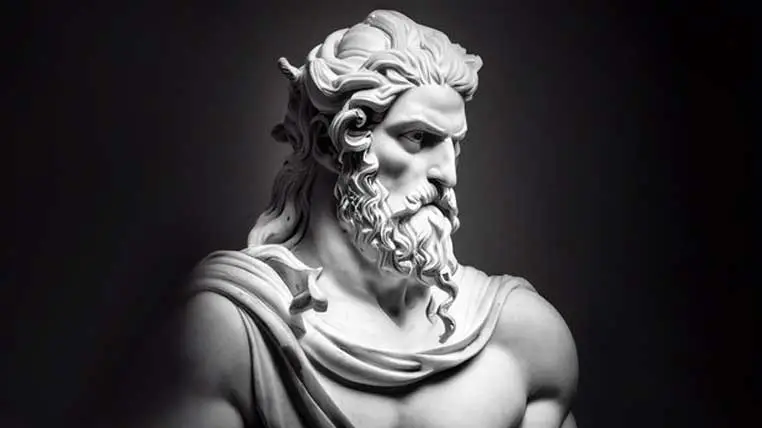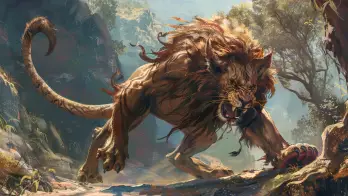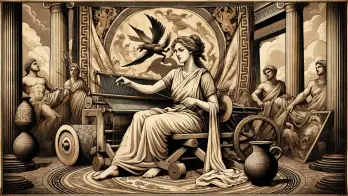Despite being one of the primary gods in Greek mythology, there are not many legends or stories about Hades due to his immense fear factor among the people of Ancient Greece.
They often uttered his name with great disdain and disgust.
In artistic depictions, Hades is portrayed holding a bident and accompanied by Cerberus, the three-headed guard dog.
The Partition of Zeus
The story of the god of the Underworld starts with the Partition of Zeus.
Following the Olympians’ victory over the Titans, the three sons of Cronos and Rhea divided the universe among themselves.
Zeus was given the sky, Poseidon took over the rivers, seas, and oceans, and Hades was left with the Underworld (also known as the Infernum or Tartarus):
The sons of Cronos are three, and of Rhea, all have we for mother;
Zeus and I, and Hades, ruler of the dead below.
The world in three was parted,
And to each was given his share;
The hoary deep to Neptune’s hand his watery empire gave;
To mine was given the gloomy dark abode of shades beneath;
The vaulted heaven to Zeus was given, with clouds and glorious light;
The broad earth to all was left, with all things it doth bear.
While the rest of the gods laughed and joked in their Olympus, the melancholic Hades, seated on his golden throne in the great underworld kingdom, meticulously examined and recorded any mistakes made by mortals on Earth.
Family Tree
According to Greek mythology, Hades was one of the six children of the Titans Cronus and Rhea.
His family tree includes:
Parents:
- Cronus (father)
- Rhea (mother)
Siblings:
- Hestia (sister)
- Demeter (sister)
- Hera (sister)
- Poseidon (brother)
- Zeus (brother)
Spouse:
- Persephone, the daughter of Demeter
Hades was one of the six children of the Titans Cronus and Rhea, who were themselves children of the primordial deities Gaia (the Earth) and Uranus (the Sky).
In Greek mythology, Cronus was told that he would be overthrown by one of his own children, so he swallowed his first five children, Hestia, Demeter, Hera, Poseidon, and Hades, as soon as they were born.
However, Rhea managed to save Hades by hiding him from Cronus and giving him to the care of the earth goddess Gaia.
When Hades grew up, he was crucial in overthrowing Cronus and the Titans, along with his siblings Zeus and Poseidon.
After the Titans were defeated, the three brothers drew lots to divide up the world, with Zeus becoming the ruler of the skies and heavens, Poseidon the ruler of the seas, and Hades the ruler of the underworld.
He was married to Persephone, the daughter of his sister Demeter, the goddess of agriculture and the harvest. Persephone was abducted by Hades and taken to the underworld, where she became his queen.
Although Hades and Persephone did not have any children together in Greek mythology, some variations of the myth suggest they had a son named Zagreus, who was later identified with the god Dionysus.
However, this version of the myth is not widely accepted.
Guardian of the Underworld
According to Greek mythology, mortals had to journey to the Underworld when they died.
Once the person died, Thanatos (the equivalent of the Angel of Death in other cultures) appeared and grabbed their soul. The god Hermes then took the soul to the gates of Tartarus.
The entrance to the underground kingdom was guarded by the three-headed dog, Cerberus, who prevented living beings from entering and the dead from escaping. The river Styx flowed through the Underworld, and it was believed that souls had to cross the river to enter the realm of the dead.
Hades’ kingdom was divided into different regions:
- The Elysian Fields, also known as the Isles of the Blessed, was a section reserved for heroic and virtuous souls;
- Tartarus was a bottomless, dark pit where the evilest souls were punished;
- Asphodel Meadows was the neutral area where ordinary souls resided.
Here, aided by the many creatures who resided in the Underworld, the god punished those who did not respect the Olympian gods.
In Greek mythology, the Underworld was believed to be home to various monstrous and divine creatures:
- Cerberus – A three-headed dog with a serpent’s tail who guarded the entrance to the underworld;
- Charon – The ferryman who transported souls across the river Styx;
- Furies (Erinyes) – Three female spirits who punished wrongdoers and brought justice to the underworld;
- Hecate – A goddess of witchcraft and magic who was associated with the underworld;
- Minotaur – A creature with the body of a man and the head of a bull, believed to reside in the labyrinth in the underworld;
- Shades – The souls of the dead who resided in the underworld;
- Sirens – Enchanting creatures who lured sailors to death with beautiful songs;
- Titans – A group of powerful deities who ruled before the Olympian gods and were imprisoned in Tartarus after a war with the Olympians;
- Harpies – Winged female creatures with the face of a woman and the body of a bird, who were associated with death and the underworld.
Depictions of Hades
Hades was created by the Greeks to embody everything that lay beneath the earth.
In Greek mythology, the god of the dead was often portrayed as a stern and unyielding figure, who ruled the underworld with absolute authority.
He was depicted as a mature man with a beard and often wore a helmet that made him invisible to mortal eyes. His appearance was usually dark and ominous, reflecting his role as the god of the dead.
Hades’s powers and abilities made him a feared and revered deity in Greek mythology. Here are some of his most notable powers:
Control over the dead: As the god of the underworld, Hades had complete control over the souls of the dead. He decided who was allowed to enter the underworld and who was not, and he determined the fate of each soul based on their deeds in life.
Invisibility: The god of the dead was often depicted wearing his helmet of invisibility, which allowed him to move about undetected and remain hidden from mortal eyes.
Wealth: The underworld was believed to be a place of great wealth, and Hades was the lord of all its treasures. He was often depicted holding a scepter or a key, symbols of his power over the riches of the earth.
Fear: Hades was a powerful and feared god, and his name was often invoked to scare people into obedience or submission.
Control over plants: Hades was also believed to have some control over the growth of plants and crops, as he was the god of the earth and the underground.
The god lives in a golden palace guarded by Cerberus. Inside the palace is a large room, and in the center is a massive gold throne. From there, surrounded by the three judges of death, Hades passes judgment on the condemned.
Behind the golden palace is a garden full of fruit trees, and Hades has a herd of black cattle which the shepherd Menoite drives on the meadows of asphodel. The animals and plants sacred to Hades include mint, cypress, owls, white poplar, and asphodel.
At the lord of the underworld court, there are many characters with symbolic connections to the underworld.
These include Ascalaphus (a demon transformed by Demeter into an owl), Charon (Hades’ ferryman in the underworld), Erinyes (judges of the dead), Thanatos, Cerberus, Menoite, and Oneiroi (the gods of the rivers of the underworld).

The Abduction of Persephone
Feeling lonely in his kingdom, Hades desired a wife, but no goddess wanted to go willingly to the gloomy realm he ruled with aplomb as the god of death. So Hermes sent his scouts to search for a suitable wife for Hades.
They found Persephone, the daughter of the goddess Demeter, the goddess of agriculture and crops of the field, and Zeus. “Persephone” in ancient Greek meant “the one lost through death.”
Knowing that Demeter would never agree to a marriage, the god of the Underworld asked his brother Zeus for her hand in marriage.
Unable to refuse his brother, Zeus agreed but with one condition: Hades himself had to take the girl to the kingdom of the dead.
Zeus knew very well that Persephone was constantly guarded by her mother, Demeter, who would never allow the girl to reach the underworld kingdom.
One day, as Persephone was picking flowers with the Oceanids, Artemis, and Pallas, the daughter of Triton, Hades appeared from a crack in the earth’s crust, grabbed the girl, and dragged her with him to the Underworld.
Demeter, grieved by the disappearance of her beloved daughter, left Olympus and set off in search of Persephone.
Some legends tell that during this period, Demeter forbade the earth to bear fruit, and nothing grew, and everything green withered and died.
Helios, the sun god who saw everything that happened on earth, felt pity for the goddess and told her about the abduction of Persephone.
Eventually, pressured by Demeter and the prayers of the starving mortals, Zeus ordered Hades to release the girl.
The master of the Underworld complied, but before Persephone left the realm of the dead, the god gave her a pomegranate seed to eat. Sent by Zeus to release her, Hermes led Persephone back to Olympus.
Hades’ trick, however, was to bear fruit.
Persephone was forever bound to the world of the dead through the power of the pomegranate seed. Every winter, Persephone returns to the Underworld and rules alongside Hades until the coming of spring.
This explains why winter is Demeter’s season of despair when vegetation dies. When spring comes and Persephone returns from the Underworld, nature returns to life.
The theme of the mother looking for her abducted child has entered the folklore of all peoples under different variations, especially in the Slavic, Latin, and even Germanic peoples.
Myths and Legends
Hades, the Greek god of the underworld, played a significant role in many myths and legends.
While the story of his abduction and marriage to Persephone is perhaps the most well-known, other tales involve Hades and his dealings with mortals.
Orpheus, the famous musician and prophet, once journeyed to the underworld in an attempt to retrieve his deceased wife, Eurydice.
He managed to persuade Hades and Persephone to allow him to take her back to the world of the living, but on one condition: he must not look back until they were safely out of the underworld.
Unfortunately, Orpheus couldn’t resist the urge to turn around and check on his wife, causing her to be lost forever.
Another myth involves Theseus and Pirithous, who ventured into the underworld to kidnap Persephone.
Hades tricked the pair and punished them severely. Pirithous was forced to sit on the “Chair of Forgetfulness” forever, while Theseus was eventually rescued by Heracles.
Sisyphus, a mortal king, also crossed paths with Hades. Sisyphus outwitted the god of death and managed to cheat death for a time, but was eventually punished by the god of the Underworld.
After his death, he was forced to roll a boulder up a hill in the underworld for all eternity.
Heracles, one of the most famous heroes of Greek mythology, also entered the underworld as part of his Twelve Labors.
He was tasked with capturing Cerberus, the three-headed dog who guarded the entrance to the underworld. Hades allowed Heracles to take the dog, as long as he promised not to harm him.
Cult and Worship
The temples dedicated to Hades were known as plutonia (or nekyomanteion) and were used for necromancy rituals, which involved summoning the shadows of the dead.
Hades and his wife Persephone were believed to watch over the oracles of the dead (nekromanteia), such as those found in Cumae (on the Italian peninsula) and Thesprotia (in the Peloponnese).
References to the cult of the underworld god can be found in works such as Seneca’s Oedipus and Statius’s Odyssey and Thebaid.
Hades was a feared deity, so the ancient Greeks often used epithets and euphemisms to refer to him. To appease him, they would beat the ground.
All chthonic sacrifices, including those made to Hades, were left to bleed into a well or crack in the ground, and those who made the sacrifice would turn away.
When someone died, it was customary to place an obol in their mouth or beside them, so they could pay the ferryman Charon to cross the river to the realm of the dead.
At Ancient Theory we only use trusted sources to document our articles. Such relevant sources include authentic documents, newspaper and magazine articles, established authors, or reputable websites.
- Mark Cartwright - Hades, Ancient History Encyclopedia. worldhistory.org.
- Thomas Apel - Hades. mythopedia.com.
- Persephone - wikipedia.org [Source]
- Hades - wikipedia.org [Source]
- Henry Liddell and Robert Scott - A Greek-English Lexicon. Editura Oxford: Oxford University Press, 1996.
- Hades - Encyclopaedia Britannica. [Source]






